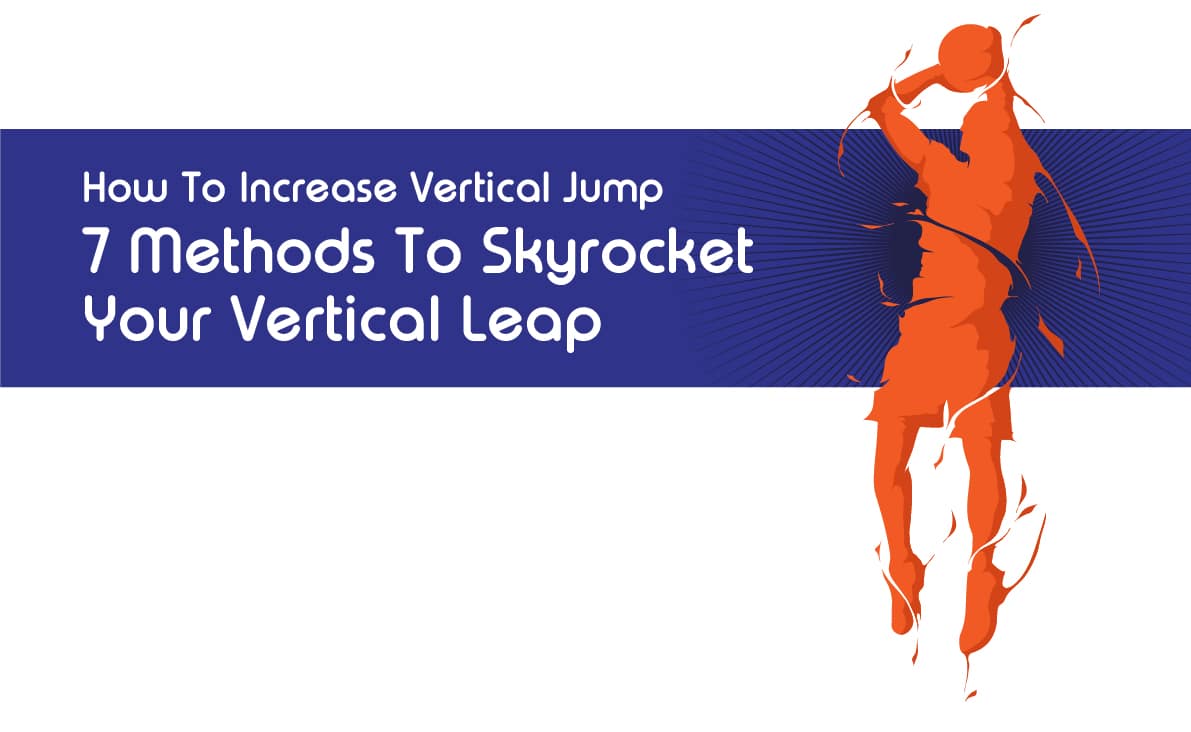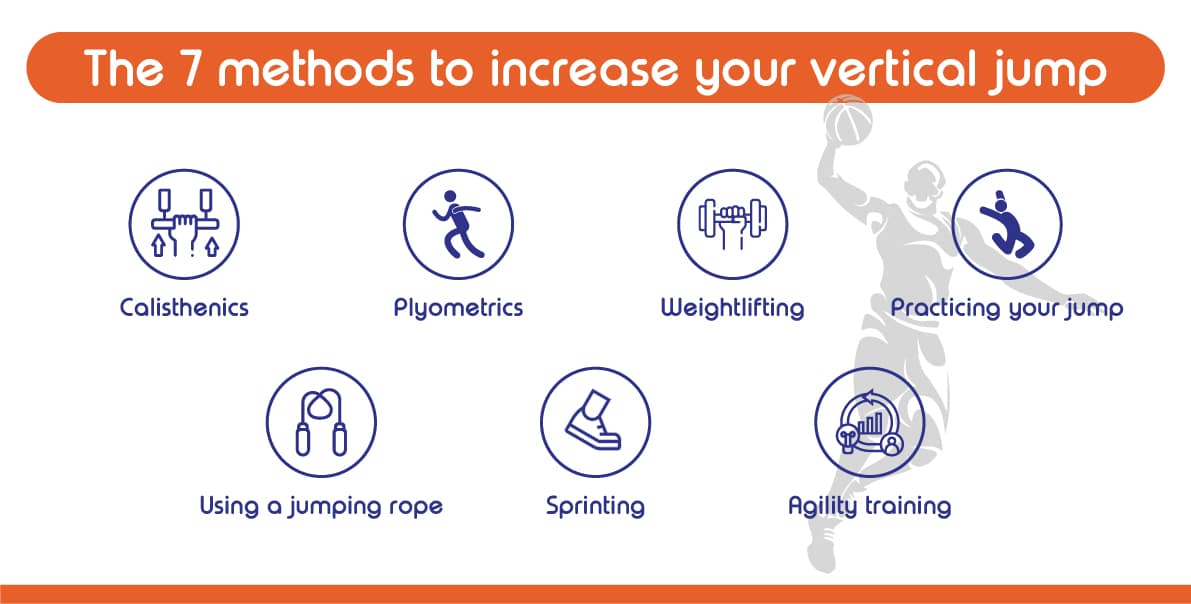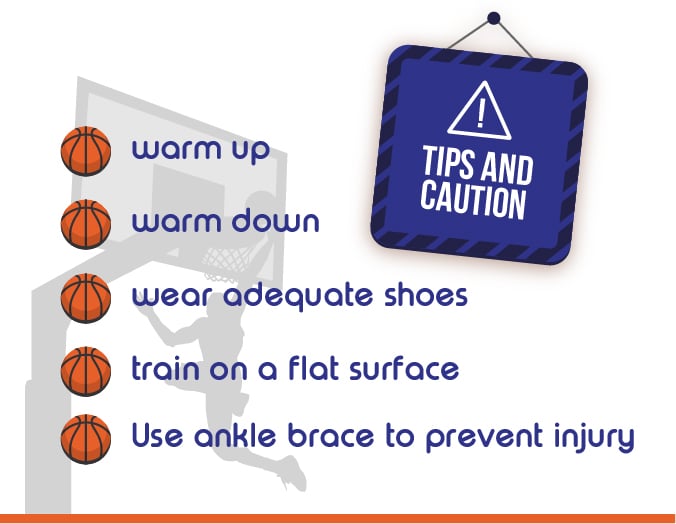
Something as simple as Jumping Higher can be a defining factor when trying to defeat your opponent on the sports field.
The Average Vertical Jump for men is anywhere between 16 and 20 inches. Meanwhile, the average for women is anything in the region of 12 to 16 inches.
Most Vertical Jump Training, which will help you be better than average, is likely to be geared towards Jumping Higher In Basketball and Jumping Higher In Volleyball.
However, this blog offers a more holistic solution to your Vertical Jump Testing challenges.
How To Increase Your Vertical Jump: 7 Methods To Skyrocket Your Vertical Leap

1- Calisthenics
Traditionally, the emphasis with Calisthenics exercises is on generating rhythm. Most of these exercises are conducted without any props or equipment. If you are using additional props for Calisthenics exercises, there is the distinct possibility that you are doing them wrong.
Among the more common Calisthenics exercises are routines like jump squats, burpees, leg raises, and planks. All of these exercises will help you strengthen large muscle groups, increase your flexibility and improve your fitness. These are all components that will contribute to an increased vertical jump.
Something as simple as an eight-week Jump Squat Routine can do a considerable amount to produce outstanding results.
Exercises | Reps per set | sets per session | rest between sets | Rest between training days | Training days per week | rest day alternatives |
|---|---|---|---|---|---|---|
Leg Raises | 10-20 | 3-5 | 20 Seconds | 24 hours | 3-4 days per week | short run |
planks | 60 seconds | 3 | 30 seconds | 24 hours | 3-4 Days Per Week | short cycle |
jump squats | 10-20 | 3-5 | 40 seconds | 24 hours | 3-4 Days Per Week | short jog |
burpees | 8-10 | 2-3 | 40 seconds | 24 Hours | 3-4 Days Per Week | short run |
2- Plyometrics
The emphasis with all plyometrics routines is actually on speed. By conducting plyometrics workouts you are actually teaching your muscles to extend and contract at very high speeds.
Plyometrics also add considerable value in sports that require jumping.
When reading up a little more on How To Jump Higher, you will learn that the generation of speed or quick bursts of speed will improve the quality of your jump.
Among the more common Plyometric Exercises are ankle jumps, depth jumps, Aztech Push-Ups, and lateral jumps.
Exercises | Reps Per Set | Sets Per Session | Rest Between Sets | Rest Between Training Days | Training Days Per Week | Rest Day Alternatives |
|---|---|---|---|---|---|---|
Ankle Jumps | 5-10 | 3-5 | 15 Seconds | 48 Hours | 3 | Aerobics |
Depth Jumps | 10-15 | 2-3 | 30 Seconds | 48 Hours | 3 | Light Weight Lifting |
Lateral Jumps | 10-20 | 3-4 | 40 Seconds | 48 Hours | 3 | Yoga |
Aztech Push-Ups | 10 | 2-3 | 40 seconds | 48 hours | 3 | weight lifting |
3- Weightlifting
Many of the exercises associated with better jumping - which have been listed here - can be significantly enhanced or made more compelling by adding weights to the various routines.
The lifting of weights, in isolation, can also do wonders for your elevation. Weight training includes but is not limited to the leg press, deadlift, leg extension, and the wall sit.
Exercises | Reps Per Set | Sets Per Session | Rest Between Sets | Rest Between Training Days | Training Days Per Week | Rest Day Alternatives |
|---|---|---|---|---|---|---|
Leg Presses | 5-10 | 3 | 30 Seconds | 24 Hours | 2-3 Days Per Week | Jumping Jacks |
Deadlifts | 5-10 | 2 | 30 Seconds | 24 Hours | 2-3 Days Per Week | Jump Rope |
Leg Extensions | 5-10 | 3 | 30 Seconds | 24 Hours | 2-3 Days Per Week | running in place |
Wall Sit | 60 Seconds | 3 | 30 Seconds | 24 Hours | 2-3 Days Per Week | lunges |
4- Practicing Your Jump
Muscle Memory is your capacity to reproduce a movement - not necessarily in a competitive environment - without actually having to put too much thought into it. You develop that capacity by repeating a routine over and over again.
- Practice Your Jump By Hopping
Hopping Up A Staircase, possibly at a sports stadium or venue, might seem like a mundane task. Well...it is. However, you are not just hopping up those stairs, you are actually jumping.
Those who compete in High Jump swear by this training method but it can be just as useful for Basketball players, Netball players and Volleyball players.5- Using A Jumping Rope
In most parts of the world, outside of the United States, this is commonly known as a Skipping Rope. Anybody who has done exercises using this rope will want to SKIP this training regimen altogether in future.
Anything more than ten minutes on a skipping rope is absolute torture - that is probably a clue as to why its use is most associated with boxers, people who can take the heat.
By its very nature, skipping requires that you jump and the harder you make this for yourself the higher you would have jumped.
- Feet Front To Back
The standard routine for the Jump Rope workout is something we casually refer to as the Feet Front To Back. This involves tossing the rope forward, under your feet, up the rear and over your head again...skipping!
While you are jumping over the rope, your one foot will bounce forward, while your other foot will bounce back, as the name would vaguely suggest. A certain level of coordination will be required to pull this off well and it can be a bit daunting for the uninitiated. Muscle memory will help you eventually get there though.
- Feet Side To Side
Before we discuss the Jump Rope routine itself, something we perhaps do not dwell on enough is the value of jumping off two feet in sports like netball, basketball and volleyball. More often than not, your feet will be together when you do this.
So, for the Feet Side To Side routine you will start the Jump Rope exercise with your feet together. When the rope comes around for the next jump, you will split your feet (obviously not too wide) and then bring the feet together again at the next repetition. It is like doing slightly less intense star jumps but with a Jump Rope in your hands.
Once again, there will be a considerable amount for you to think about and coordination is key.
Jumping over the darn rope is difficult enough, thinking about the subsequent movement of your feet is just absolutely frightening but not impossible.
- Running In Place
Once again, the name of the Jump Rope routine basically says it all. When hopping over the rope, you essentially are running in one spot - like you are on the treadmill. Every time the rope comes down, your feet are hopping over the rope but not at one time because you are “running”.
All Jump Rope routines, including this one, are more about strengthening your body’s core and less about the actual height. However, the stronger your core is the better placed you will be.
6- Sprinting
It is no coincidence that some of the best sprinters in the world are also outstanding long jumpers. Something about long jump which isn’t appreciated nearly enough is that the longest jumpers are actually the folks that have a good vertical jump. All three components - speed, length and height - are directly related.
If you just focus on the best methods for Sprint Training, you will be well on your way.
- Build Up Your Speed
I am reminded of my high school years, watching the track team train on the middle field, when a topic like this comes up. I was often bemused by the school’s major sprint athletes doing sprint repetitions of 50 and then 100 yards at what appeared to be a canter. They did three or four repetitions of 50 yards at half and three-quarter speeds.
Subsequent to that, they completed the same routine over a distance of about 100 yards. After every repetition they backpedaled to where they had started the minor sprint. The track and field coach insisted that this was the best way for his athletes to build up their speed.
I was having none of it then but years later, I have managed to confirm there is indeed a method to the madness. Sprint experts confirm this for us.
The logic behind this training technique is that it firstly prevents you from burning yourself out during training but more importantly it helps you build your sprinting rhythm. It turns out that is actually more important.
7- Agility Training For Improved Vertical Jump
A critical detail about agility training is that most of it will adequately prepare you to compete in all sports. As it just so happens, agility is a major function of the body in sports that require an impressive jump - sports like basketball, volleyball, netball and high jump.
When you have a few extra moments, just sit down in front of the television set or a computer and watch clips of the athletes competing in any one of these codes.
They are usually a very good exhibition of the agility required to compete, in almost every facet of the game - not just when trying to jump higher.
Critically, agility is something that can also be trained - more so than things like stamina and speed, which are mostly genetic gifts.
Among the more common routines are the Box Drill, Shuffle Sprint, Lateral Speed Shuffles, High Hurdle Jumps, Cone Ladder Drills and Swing Plants.
All of these drills - and others - are completed at a high intensity. It is important to stick to a set number of repetitions and be wary of the burnout risks that are associated with the workouts.
The completion of a series of Overspeed Shuffle Sprints (for example), will require the use of about three or four cones. Ordinarily, you would place those cones about three-to-five yards apart.
This is a routine where you will be completing at full intensity throughout, regardless of the resistance levels. The training regimen will also be set for both sides of your body, so that is essentially double the workout.
Most coaches will tell you that four reps of this on both sides of the body should be sufficient.
Tips and Cautions: Before Attempting Any Method

The most important precaution to take by those who wish to do some relevant training is that you ought to Warm-Up thoroughly before you start any of the required routines. Most training regimens used here require high intensity levels. You are going to be demanding a lot from your body and the body needs to be adequately prepared for that.
Equally important to the Warm-Up is the Warm Down. In addition to that it is important that you give your body the time that it needs to recover from intense jump training sessions.
Most jump training sessions are extremely heavy on the joints, especially the knees and ankles. It would be prudent of you to wear shoes that have adequate padding before embarking on a jump mission - to absorb some of that shock
When conducting any relevant training, it is also important that you do it on a Flat Surface that is not slippery.
Finally, your ankles take a lot of heat during jump routines in general. If you can, try and purchase some ankle braces to help absorb some of the workout that will come from sprint and plyometric exercises.
Conclusion
This kind of training is very specific. However, you will find that many of the available routines are suitable for all of the sports codes that need you to jump higher.
We have mentioned four of them earlier in this blog but a good jump is not limited to those codes.
This training can actually make you become a better all-round athlete altogether because of the areas of your body that are being worked on.
This training places tremendous emphasis on the calves, the thighs, the torso and the joints. Developing those regions of the body just about prepares you to take on any sports challenge.
Hey, I’m Aleksandar and I am a Basketball freak! That is why I decided to create this blog. Teaching people How to dunk a basketball and How to Jump Higher in this sport or other related sports that require vertical jumping, is my specialty. If that’s your aim, then you have come to the right place.
